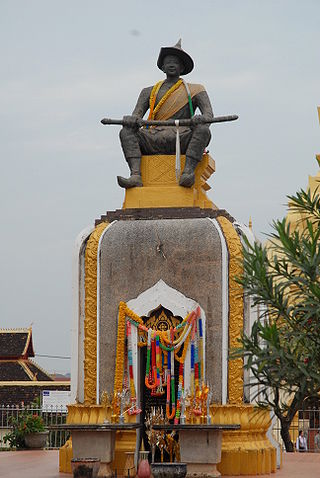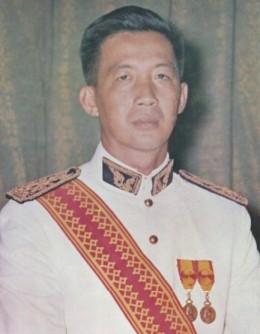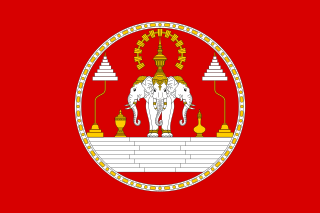
King Sisavangvong, known by his courtesy name Sisavangvong, was the last ruler of the Lao Kingdom of Luang Prabang and the founding king of the Kingdom of Laos. Born Prince Khao on 14 July 1885, he ascended the throne at the age of 18 following the death of his father. In keeping with Lao tradition, he took the courtesy name Sisavangvong.

Luang Phabang, or Louangphabang, commonly transliterated into Western languages from the pre-1975 Lao spelling ຫຼວງພຣະບາງ as Luang Prabang, literally meaning "Royal Buddha Image", is a city in north central Laos, consisting of 58 adjacent villages, of which 33 comprise the UNESCO Town of Luang Prabang World Heritage Site. It was listed in 1995 for unique and "remarkably" well preserved architectural, religious and cultural heritage, a blend of the rural and urban developments over several centuries, including the French colonial influences during the 19th and 20th centuries.

Setthathirath or Xaysettha is considered one of the great leaders in Lao history. Throughout the 1560s until his death, he successfully defended his kingdom of Lan Xang against military campaigns of Burmese conqueror Bayinnaung, who had already subdued Xieng Mai in 1558 and Ayutthaya in 1564. Setthathirath was a prolific builder and erected many Buddhist monuments including Wat Xieng Thong in Luang Prabang, Haw Phra Kaew, Wat Ong Teu Mahawihan and the Pha That Luang in Vientiane.

Prince Phetsarath Ratanavongsa (Somdej Chao Maha Uparaja Petsaraj Ratanavongsa was the 1st Prime Minister of Luang Phrabang in French Laos from 21 August 1941 to 10 October 1945, and Head of State of Laos between 12 October 1945 and 4 April 1946.

Prince Souvanna Phouma was the leader of the neutralist faction and Prime Minister of the Kingdom of Laos several times.

Sisavang Vatthana or sometimes Savang Vatthana was the last king of the Kingdom of Laos and the 6th prime minister of Laos serving from 29 October to 21 November 1951. He ruled from 1959 after his father's death until his forced abdication in 1975. His rule ended with the takeover by the Pathet Lao in 1975, after which he and his family were sent to a re-education camp by the new government.

Photisarath, son of King Visoun of Lanxang, is considered to be the most devout of the Lao kings. He banned spirit worship and built temples upon the sites of spirit shrines. His elephant fell and crushed him while he sought to display his prowess to the diplomatic corps. His son Setthathirath returned from Chiang Mai to succeed him to the throne of Lan Xang.
Somdetch Brhat-Anya Fa Ladhuraniya Sri Sadhana Kanayudha Maharaja Brhat Rajadharana Sri Chudhana Negara, better known as Fa Ngum, established the Lao kingdom of Lan Xang in 1353.

Khamphoui was the Queen of Laos by marriage to Sisavang Vatthana, the second King of Laos. She was arrested with the rest of her family and reportedly died in a re-education camp in 1982.

Vong Savang was the Crown Prince of the Kingdom of Laos. After the Laotian Civil War in 1975, he and his family were arrested by the Pathet Lao and sent to re-education camps, where they died.

The Royal Palace in Luang Prabang, Laos, was built in 1904 during the French colonial era for King Sisavang Vong and his family. The site for the palace was chosen so that official visitors to Luang Prabang could disembark from their river voyages directly below the palace and be received there. After Sisavang's death, the crown prince Savang Vatthana and his family were the last to occupy the grounds. In 1975, the monarchy was overthrown by the communists, and the royal family were taken to re-education camps. The palace was then converted into a national museum.

The French protectorate of Laos was a French protectorate in Southeast Asia of what is today Laos between 1893 and 1953—with a brief interregnum as a Japanese puppet state in 1945—which constituted part of French Indochina. It was established over the Siamese vassal, the Kingdom of Luang Phrabang, following the Franco-Siamese crisis of 1893. It was integrated into French Indochina and in the following years further Siamese vassals, the Principality of Phuan and Kingdom of Champasak, were annexed into it in 1899 and 1904, respectively.

Sainyabuli, is the capital of Sainyabuli Province, Laos. It lies on Route 4 which along with Route 13 connects it to Luang Prabang, roughly 80 kilometres northeast by road and to the Thai border across the Luang Prabang Range in the southwest. A passport control point is in the area. Sainyabuli Airport lies southwest of the town.
Setthathirath II, also called Ong Lo and Sai Ong Hue, grandson of the great ruler Suliyavongsa, was the king of the Lao Kingdom of Lān Xāng. In Vietnamese records, he was called Triều Phúc (朝福).

The Lan Xang Hom Khao dynasty or Lao royal family was the ruling family of the Kingdom of Laos from 1904 to 1975 and the group of close relatives of the monarch of the Kingdom of Laos. King Sisavang Vong was the founder of the modern family, consisting of a number of persons in the Lao royal dynasty of the Khun Lo, who are related to the king of Laos, who are entitled to royal titles, and some of whom performed various official engagements on behalf of the royal family and ceremonial duties of state when the kingdom existed. The Lao royal family are now based in France, where they work to achieve a change of government in Laos.

The Kingdom of Luang Phrabang, also called Kingdom of Luang Prabang was formed in 1707 as a result of the split of the Kingdom of Lan Xang. When the kingdom split, Muang Phuan became a tributary state of Luang Prabang. Over the years the monarchy weakened even more, and was forced to become a vassal various times to the Burmese and the Siamese monarchies.
Operation Xieng Dong was a successful defensive strike by the Royal Lao Army (RLA) against an invasion by the People's Army of Vietnam (PAVN). In early February 1971, PAVN forces swept RLA defenders from a line of hilltop positions guarding the royal capital of Luang Prabang. The city's perceived invulnerability to attack was shattered. King Sisavang Vatthana refused to leave his capital. Other Military Regions of Laos hastily forwarded to Luang Prabang's Military Region 1 any troops that could be spared from the rest of the Laotian Civil War. On 7 April, the resulting patchwork force of RLA battalions, Forces Armee Neutraliste half regiment, and Central Intelligence Agency-backed Special Guerrilla Units managed a three-pronged offensive supported by tactical aviation that surrounded and defeated the invading PAVN 335th Independent Regiment, which had gotten within eight kilometers of Luang Prabang. By 5 June 1971, the 335th was in full retreat.
Chakkaphat Phaen Phaeo (1415–1481) reigned as King of Lan Xang from 1442 to 1480, succeeding the Maha Devi after an interregnum of several years. He was born in 1415 as Prince Vong Buri, the youngest son of King Samsenthai by Queen Nan Keo Yot Fa daughter of King Intharacha of Ayutthaya. When he came of age he was appointed as Governor of Vientiane. He was invited to ascend the throne several times during the succession dispute orchestrated by the Maha Devi, but refused. The Council of Ministers finally persuaded him to become king in 1441, after they had failed to find any other candidate. He still refused to be crowned and avoided the ceremony for many years. Finally bowing to custom in 1456, he was formally coroneted and assumed the reign name and title of Samdach Brhat-Anya Chao Sanaka Chakrapati Raja Phen-Phaeo Bhaya Jayadiya Kabuddha. The regnal name is significant because it translates in Pali to cakkavattin, meaning "Universal Buddhist Monarch." Vong Buri, and the court, were claiming enough political and religious power to unify the kingdom, and warn surrounding kingdoms, despite the upheaval caused by the Maha Devi and interregnum in Lan Xang from 1428-1442.

The Kingdom of Luang Prabang was a short-lived puppet state of Imperial Japan, which existed from 9 March 1945 to 12 October 1945.














